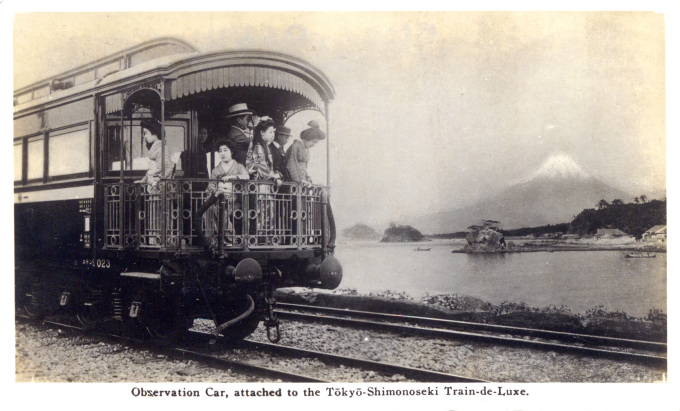
Class Maite 39 Observation Car attached to the Tokyo-Shimonoseki Train-de-Luxe, c. 1930, passing Mt. Fuji.
See also:
Tokaido Main Line, c. 1910.
J.N.R. Limited Express commemorative advertising postcard, October 1958.
Tokaido Main Line “Kodama”, c. 1960
“The inauguration of the Limited Express between Tokyo and Shimonoseki has been a popular departure on the part of the Imperial Japanese Railways. The new service was started in June [1912]. The trains leave the Shimbashi station at Tokyo at 8.30 every morning and arrive at Shimonoseki at 9.38 the following morning. They leave Shimonoseki at 7.10 p.m. each day and arrive at Tokyo at 8.23 p.m. the following day.
“The seven cars of which the new trains consist comprise a mail and baggage car, second-class cars, a second-class sleeping car, a dining car, a first-class passenger car, first-class sleeping car and observation car. Generally speaking the new express may be called Trains-de-Luxe, leaving nothing to be desired in point of appearance, equipment, and accommodation.
“The dining cars, and the observation cars are particularly noticeable, the former being far larger and more roomy than those hitherto used in Japan and the interior conspicuous for the thorough improvement effected in every detail that may add to the comfort and convenience of passengers.
“The observation cars are for the use of first-class passengers only, and consist of three sections, namely compartments for passengers, the library, and the compartment for the purposes of observation. This last section is provided with upholstered wicker chairs and smoking tables, etc. With large clear window panes on each side, the car gives a most satisfactory view of the country through which the train passes. The carved wood ceilings, the electric lamps, in the shape of Japanese lanterns, and the paper-screen like ventilating windows – all these give the cars a peculiarly Japanese touch.”
– The Far Eastern Review, August 1912
“The Tokaido, the main trunk line from Tokyo to W. and S-W. points, skirting the Pacific coast, passes through Yokohama, Közu, Mishima, Numazu, Shizuoka, Nagoya, and other places to Kyoto, Osaka, and Kobe.
“At Yamakita, about 10 m. from Közu, where extra locomotives are attached, trains begin their climb up the steep grade along the base of Mt. Fuji, the highest point being at Gotemba, the principal departure station for the ascent of the mountain. A tunnel, 4.8 m. long, is now being driven from Atami to a point near Mishima to avoid this sharp grade and to gain distance.
“The line crosses good-sized rivers, Lake Hamana (a large lagoon), and passes through tunnels and many country towns and villages, all of interest to foreign travelers.”
– Pocket Guide to Japan, Imperial Government Railway, 1925
- Commemorative postcard from 1909, depicting the Tokaido Main Line steaming past Mount Fuji.
- The 6200-class steam locomotives were British-built, and used for Tokaido Main Line service from 1898-1914.
- Tokaido Main Line express departing Tokyo, c. 1920.
- A C51 locomotive pulling Tokaido Main Line carriages past the Imperial Hotel, at Yamashitacho-bashi, on arrival into Tokyo, c. 1920.
“The Tokaido route takes its name from the ancient highway connecting the Kansai region (Kyoto, Osaka) with the Kantō region (Tokyo, née Edo) through the Tokai region (including Nagoya). Literally, it was the Tokai road [Tokai-do], or Road through Tōkai. One of the first priorities of Japanese railway planners was to establish a rail line and service from Tokyo to the Kansai region. After construction of a main line following the feudal Nakasendo highway was abandoned, the main line from Tokyo to Kobe, via Yokohama, Odawara, Shizuoka, Hamamatsu and Nagoya, was completed in 1889. At the start of service, there was one Tokyo-Kobe train in each direction per day, taking over 20 hours each way.
“The ‘Tokaido Line’ moniker for the rail route was formally adopted in 1895 for the Tokyo-Kobe after through-service to Shimonoseki and Moji (via the San’yo Main Line beginning at Kobe) was begun. Express service between Tokyo and Kobe began in 1896, sleeper service in 1900, and dining car service in 1901. In 1930 the first Tsubame Kokutetsu [swallow express] was introduced, pulled by the C51 steam locomotive (the first Japanese-built high-speed passenger locomotive and first produced in 1919), reducing the Tokyo-Kobe travel time to 9-hours – a significant reduction from the twenty-hours required in 1889 and fifteen-hours in 1903.”
– Wikipedia


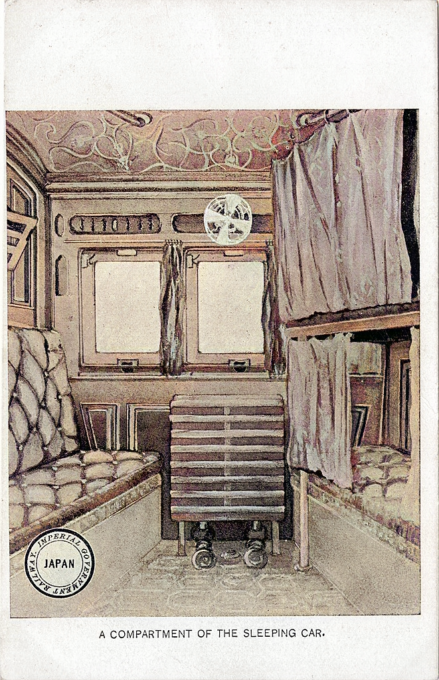
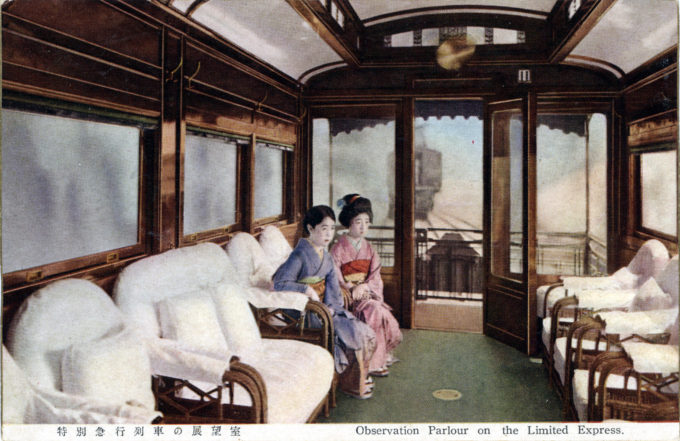
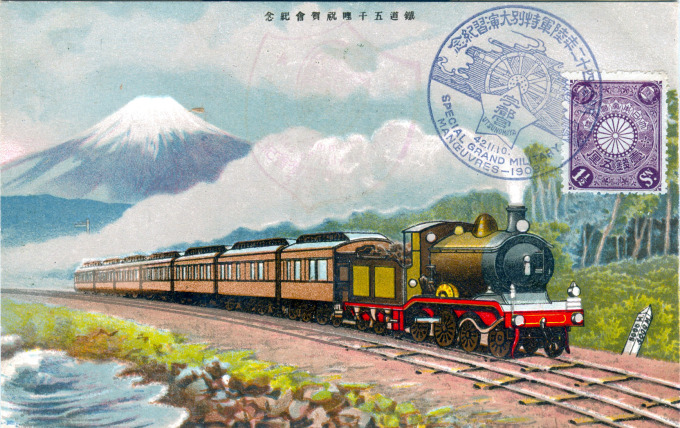
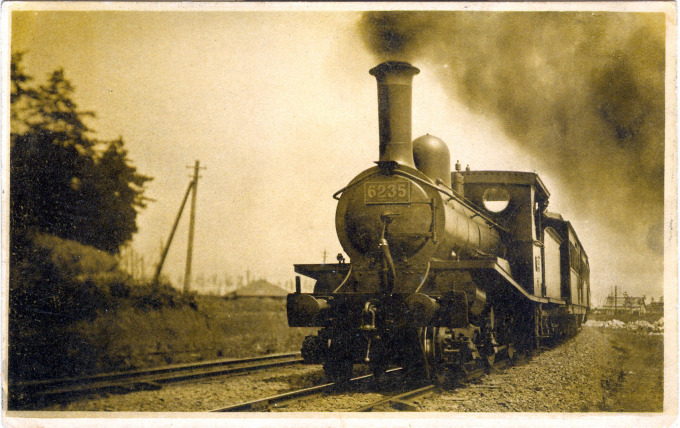
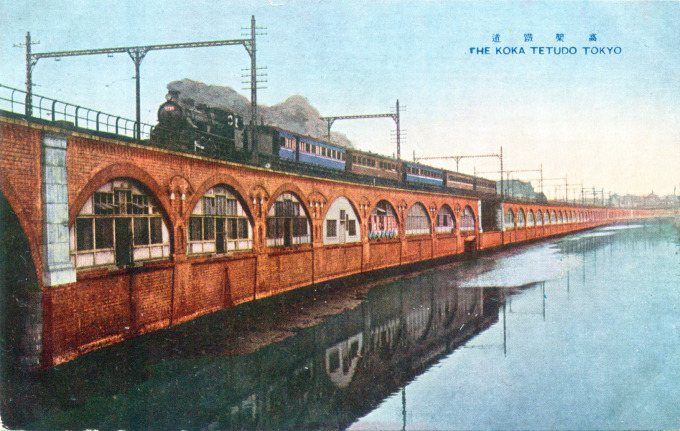
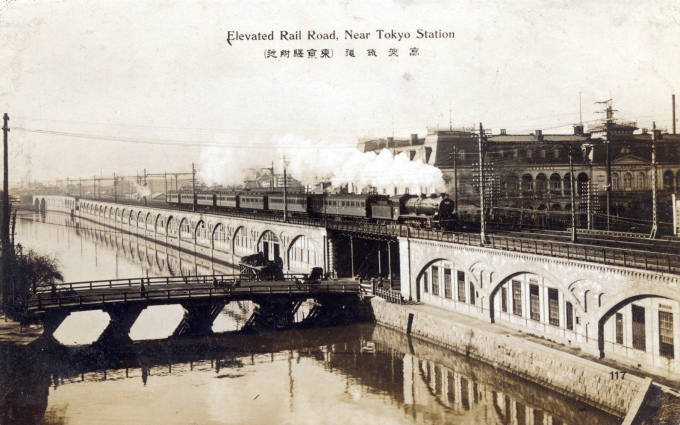
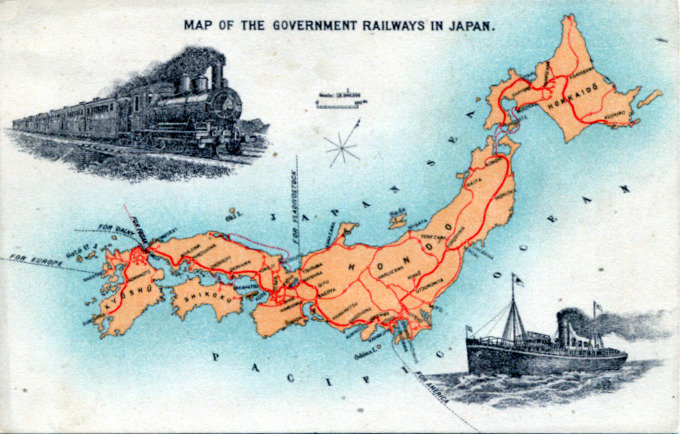
Pingback: Tokyo Station, 1945-1960. | Old Tokyo
Pingback: Tokyo Station, 1914-1940. | Old Tokyo
Pingback: “5000-Mile” Celebration, Imperial Government Railway, 1909. | Old Tokyo
Pingback: Sasago Railway Tunnel (Chuo Line), c. 1930. | Old Tokyo
Pingback: Hayama Beach, Kamakura, c. 1910. | Old Tokyo
Pingback: "The Express Train at Sea-Coast of Shinagawa," 1912. | Old Tokyo
Pingback: Tokaido Main Line "Kodama", c. 1960. | Old Tokyo
Pingback: E10-class steam locomotive, c. 1960 reprint. | Old Tokyo
Pingback: Imperial Railway General Office, Tokyo, c. 1920. | Old Tokyo
Pingback: Tokaido Main Line, c. 1910. | Old TokyoOld Tokyo
Pingback: JR Central Lowers Earnings Forecast: Yomiuri - Asia Financial News
Pingback: Steam freight locomotive (6700-Class/6760-series), c. 1920. | Old Tokyo
Pingback: Shimonoseki Station, Shimonoseki, Yamaguchi Prefecture, c. 1910. | Old Tokyo